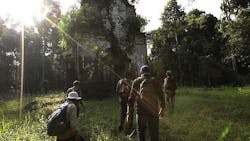Sydney, Australia--Using airborne light detection and ranging (LIDAR) technology, archaeologists have discovered a lost city that thrived on a mist-shrouded Cambodian mountain 1200 years ago. Damian Evans, director of the University of Sydney's centre in Cambodia, was a co-leader of the expedition. The discovery of the city, Mahendraparvata, includes temples hidden by jungle for centuries—temples that archaeologists believe have never been looted.
The discovery was made possible by a LIDAR instrument (http://www.laserfocusworld.com/articles/print/volume-48/issue-05/features/wind-energy-gets-a-boost-from-wind-turbine-lidar.html) strapped to a helicopter that criss-crossed a mountain north of the Angkor Wat complex, providing data that matched years of ground research by archaeologists. Archaeologists and exploration and mapping experts have uncovered more than two dozen previously unrecorded temples and evidence of ancient canals, dykes, and roads using satellite navigation co-ordinates gathered from the instrument's data.
Fairfax Media recorded the discovery of the first five temples after pushing through landmine-strewn jungle, swollen rivers and bogs with the expedition on a mountain called Phnom Kulen, 40 km north of Angkor Wat in northwestern Cambodia. Mahendraparvata existed 350 years before Angkor Wat, the Hindu temple that has captivated interest across the world and is visited by more than 2 million people each year. The LIDAR instrumentation peeled away the jungle canopy using billions of laser pulses, allowing archaeologists to see for the first time structures that were in perfect squares, completing a map of the city which years of painstaking ground research had been unable to achieve.
French-born archaeologist Jean-Baptiste Chevance, director of the Archaeology and Development Foundation in London, who was also a leader of the expedition, said it was known from ancient scriptures that a great warrior, Jayavarman II, had a mountain capital, "but we didn't know how all the dots fitted, exactly how it all came together. Over many years Chevance and his staff had crossed ancient roads and passed ancient structures they suspected were there but could not see because they were hidden by jungle and earth. The foundation's exploration and mapping expert, Stephane De Greef, has now confirmed the location of almost 30 previously unidentified temples using the LIDAR data.
The discovery, to be published in the Proceedings of the National Academy of Sciences, will prompt scientific excavation of the most significant sites by archaeologists seeking to discover what life was like for a civilization about which very little was known, including why it was abandoned to the forest. It will also allow archaeologists and historians to learn more about the evolution of Angkor, the enormous political and religious empire that dominated most of southeast Asia for 600 years.
SOURCE: The Sydney Morning Herald; http://www.smh.com.au/world/lost-horizons-mediaeval-city-uncovered-20130614-2o9p3.html

Gail Overton | Senior Editor (2004-2020)
Gail has more than 30 years of engineering, marketing, product management, and editorial experience in the photonics and optical communications industry. Before joining the staff at Laser Focus World in 2004, she held many product management and product marketing roles in the fiber-optics industry, most notably at Hughes (El Segundo, CA), GTE Labs (Waltham, MA), Corning (Corning, NY), Photon Kinetics (Beaverton, OR), and Newport Corporation (Irvine, CA). During her marketing career, Gail published articles in WDM Solutions and Sensors magazine and traveled internationally to conduct product and sales training. Gail received her BS degree in physics, with an emphasis in optics, from San Diego State University in San Diego, CA in May 1986.
